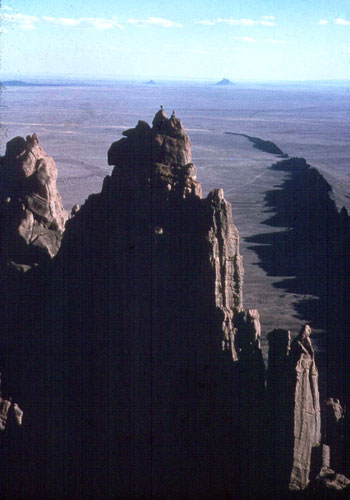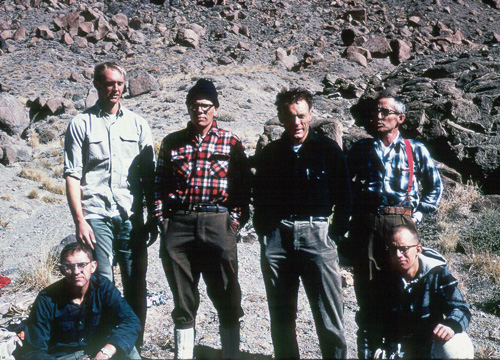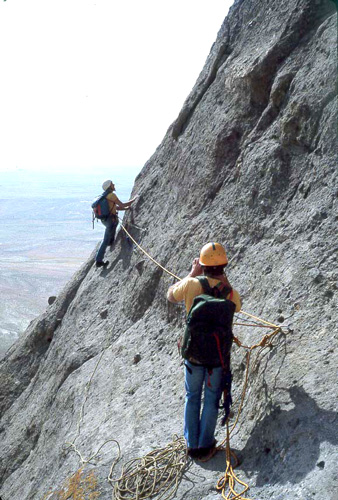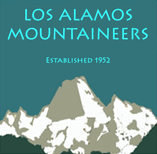|
6. Shiprock and the
Los Alamos Mountaineers
LAM History Index |
Go
to Previous Topic |
Go to Next Topic Of the many natural
wonders within a day's drive of Los Alamos, Shiprock is perhaps the most
spectacular and mysterious. Over many years, Don Liska and other members
of the Mountaineers have been a large part of the history of climbing
Shiprock. During an exciting 2006 presentation to the Mountaineers, Don
described his role, and that of other Mountaineers, in the history of
Shiprock.

Fig.
1. Don and Alice Liska atop Shiprock
(Ernie Anderson photo, taken from a plane circling the peak, 10/14/67.
This photo also appears in Eric Bjornstad's book "Desert Rock.")
Don noted that Shiprock
was considered one of the 3 great mountaineering challenges in North
America during the 1930's (along with Mt. Waddington and Devil's Tower)
until it was finally climbed by a Sierra Club group in 1939. Don said,
"After coming to Los Alamos and joining the Mountaineers, we made Shiprock a major climbing objective for the club. I had first climbed
Shiprock in April 1959 [before moving to Los Alamos] barely 20 years
after the Sierra Club did the first ascent in 1939 and 7 years after
only the second ascent by Tom Hornbein et. al. in 1952. Ours was the
last party to climb the infamous 'Double Overhang,' first climbed by the
Sierra Club using ice pitons, just three weeks before Pete Rogowski
discovered the much easier 'Step Around' pitch. My 1959 climb continued
to hold me in awe of this famous edifice. Shiprock in those days still
represented an extremely attractive, wild and difficult climbing
adventure for would-be extremists, and many well known rock climbers
made the climb in the 50's and 60's, the same era when big wall climbing
in Yosemite was developing. The complexity and length of its route, the
number of ropes required by a pair of climbers to achieve a safe ascent
(four), the heavy loads of equipment and water, the potential for a dry
bivouac, the heat, etc. tended to ward off casual ascents. Perhaps
sparked by my own personal fervor there quickly developed in Los Alamos
a few climbers who became 'extreme Shiprock enthusiasts' such as Larry Dauelsberg and especially Ernie Anderson as prime participants but also
Mike Williams, Carl Keller, Eichii Fukushima, Larry Campbell, and Dave
Brown. I believe that fervor has cooled considerably in recent decades
and Shiprock today has become more of a 50 classics peak baggers
target."

Fig.
2. Los Alamos climbers after the 106th ascent of Shiprock, 10/22/66.
Standing (L to R): Larry Dauelsberg, George Goedecke, Don Liska,
and Ernie Anderson. Sitting: L-Detzel, R-Breisch.
"Still, already by 1959
we were the 43rd party to summit Shiprock. In subsequent years, the
Mountaineers probably climbed Shiprock more than any other group did,
with perhaps 50 to 60 ascents. By the time of our third ascent in
October 1967 we were the 112th party to summit. On this climb Alice
Liska became the 15th woman to make the top, which in those days
frequently required a bivouac. In 1968 I joined Harvey Carter on first
ascents of many of the major towers that cluster around the base of
Shiprock. Some of these were more demanding than Shiprock itself and
most have not been repeated. Sextant, for instance, took us 3 days as
opposed to only 12 hours for the standard Shiprock route, once the way
is known. At any rate, over the years I have been involved in a record 9
ascents of the standard route."
"One early climbing partner, John Marshall, blessed Shiprock with the
moniker 'Shit-Rock' due to really bad rock at the mouth of the Honeycomb
Gully, which we explored at considerable risk. Even so it was here that
we one day found a camera that had plummeted down the gully at some time
past, fortunately with no body attached. It was badly smashed. The upper
Honeycomb Gully is the accident scene in Tony Hillerman's 'Fallen Man'
mystery novel."
Dave Brown remembers that Shiprock was one of the best trips he has ever
done with the Mountaineers. They did the climb in two days, with an
intentional bivouac. From there they saw the long shadow of Shiprock
stretching across the desert floor. He noted that "It's the only
mountain that you rappel down to get up, and jumar up to get down."
On October 12, 1969, the Mountaineers climbed Shiprock on the 30th
anniversary of the first ascent. Ernie Anderson organized this climb and
provided a summit register to leave on top. The climbing party consisted
of George Bell, Will Siri, Eiichi Fukushima, and Mike Hart. Will Siri
was a well-known Everest climber from Seattle, and a leader of the
Sierra Club. David Brower, who had led the first ascent in 1939, was
invited but could not come, so he sent Will Siri instead. Larry Campbell
and Mike Williams took movies of the ascent, but Larry says that the
film was damaged in processing. Eiichi believes that this was the last
climb of Shiprock before the accident the next spring that led to its
closure by the Navajos.

Fig.
3. Norbert Ensslin and Mike Fazio on the friction traverse, one of the
pitches where
a rope needs to be left behind on the way up to safeguard the return (D.
Liska photo).
Don Liska says that
"The accident on Shiprock that occurred during the period March 25-28,
1970 was arguably the most significant that the Los Alamos
Mountaineering Club was ever involved in. This accident culminated in
the official closure of the entire Navajo Reservation to climbing, a ban
which exists to this day. Prior to this, only Totem Pole and Spider Rock
had been placed off limits (after 1962) though the winds of change were
in the air and Shiprock had already claimed two lives in the 31 years
since its first ascent, so the traditional Navajo fear of death
therefore entered into the closure decision. With increasing traffic by
climbers, this decision was nearing a critical stage in 1970." Don
Liska's description of the accident is summarized below. (It is also
reported in the American Alpine Club's 'Accidents in North American
Mountaineering", 24th annual report of AAC Safety Committee, 1971, pp
8-11.)
"On Thursday March 26, 1970 a three-man party consisting of Jim Smith
and Bill Bull, both from Boulder, and George Andrews from Menlo Park
started up the standard route on Shiprock intending to climb to the main
(north) summit that day, bivouac at the 'U-Notch' below the Horn pitch
that night and climb the south summit on Friday before descending. There
was a second party at base camp as they left, including Don Liska and
Larry Dauelsberg of Los Alamos, along with Bill Hackett of Las Cruces
and Dave Beckstead of Colorado Springs. We intended on scouting a new
and difficult direct aid route up the west face of the rock to the
'U-Notch' where the first party was intending to bivouac. Our route was
totally pioneering and we had little idea of the time required to reach
the notch or of the difficulties along the way. We expected two or three
bivouacs."
"The weather that day was overcast with a forecast of clearing. As the
Smith party broke camp early on Thursday we briefly discussed their
climb and the first premonitions of possible difficulties arose when
they informed us that they did not intend to leave a handline at the
friction traverse, a steep, tricky, and exposed 125' pitch on the east
face of the rock below the second rappel. Since two of our party had
several times climbed Shiprock and knew all its hazards we warned them
that the traverse could be a difficult place to retreat across in wet or
snowy conditions. Then we parted and went our separate ways. We started
up our route over the 'Nest' and placed our first bivouac at the base of
the huge west wall where direct aid climbing was to begin. About 1 AM
early Friday a fast moving cold front out of the NW caught both climbing
parties high on the peak in their respective bivouacs."
"As we learned later, the Smith party had in fact not reached anywhere
near the U-Notch but had bivouacked on the chockstones below the first
rappel on the east face, just under the 'Colorado Col.' We, however,
were caught above the 'Nest' and covered in a deep blanket of wet snow.
As soon as daylight allowed, we began a series of rappels off the face
abandoning most of our equipment in a hasty retreat. We reached the base
of the rock about 600' below by 10:30 AM. By this time a foot of snow
blanketed the desert and enshrouded Shiprock and the storm continued.
For now, our major concern was our own retreat from Shiprock but we
began to realize that the Smith party might be trapped in a very
precarious position if they indeed had reached the 'U-Notch' for their
bivouac and had not protected their retreat across the friction traverse
with a fixed handline. As it turned out, the Smith party was in a much
more favorable position at this point but they still faced a desperate
situation ahead."
"Our fortunes picked up unbeknownst to us with the arrival the night
before of a second climbing party while we were in bivouac. An old
climbing pal Reed Cundiff (who did the first ascent of the SW ridge of
the Needle in the Sandias) and his climbing partner from Las Cruces
arrived in a VW intending their own climb of the rock the day the storm
arrived. The six of us now teamed up to pursue what we had reason to
believe could be a very serious rescue emergency of the Smith party.
Fortunately Reed had a VW and with its rear engine weight and the five
of us jumping on the bumper and pushing, we were able to work the
vehicle through the 5 miles of deep snow to the Red Rock 'highway' and
we then sped to the town of Shiprock freezing cold and mud-spattered.
With four jammed inside the car, two of us sat on top with our feet
through the sun roof barely hanging on as the sleet and wet snow
continued."
"A Navajo tribal cop soon stopped us but gave full cooperation when he
learned the details of our predicament. He escorted us into Shiprock
where we took a motel room and called Los Alamos for more LAMC help, and
Ernie Anderson, Eiichi Fukushima, and Bill Gage set out for Shiprock. In
the meantime, the tribal police drove Cundiff and partner to the Rock in
a 4WD to reconnoiter. Cundiff reported difficulty in even reaching the
top of the talus near the start of the route. He did not see signs of
the Smith party though as things turned out they were within 500' of
them at that point." [An interesting sidenote to this story is that the
cop that pulled over the LAMC party was Nick Saiz, the same state
trooper that was shot and wounded in the 1967 raid on the courthouse in
Tierra Amarilla. This event made national headlines at the time and was
often on the minds of later Los Alamos Mountaineers as they traveled
through Tierra Amarilla on the way to climb the Brazos Cliffs.]
"That evening as the storm was beginning to abate and the temperature
was dropping rapidly, Liska and Dauelsberg returned to the rock with
Navajo Tribal Authority 4 WD's, radios, etc. hoping to make contact with
the Smith party. They found Smith and Bull wandering dazedly near their
vehicle, disoriented and hypothermic. Smith was bleeding and both were
hurt and shaken. They reported their party had fallen and they had to
leave Andrews 150' above the 'Cave Pitch' (the first pitch) in the Black
Bowl near the Topp memorial plaque. Liska and Dauelsberg saw this as a
relatively straightforward rescue and radioed the other two climbers
still at the motel to come on out. By 11 PM under clear, cold skies we
were all gathered ready to attack the climb with a Stokes litter, first
aid kit, radios, lights, and essential climbing gear. Icy talus and snow
hampered the way."
"It turned out that Smith and Bull had left a 300' reepschnur on their
last rappel to the base. We found this rope indispensable in allowing us
to prussik up the difficult Cave Pitch and its now icy overhangs to the
scene of the accident some 200' above the base of the rock. We reached
Andrews around 2 AM and administered aid to his broken shoulder. We
loaded the hypothermic and pain-ridden victim in the litter and lowered
him over the overhangs to the base where he was man-hauled a very rough
half mile over icy talus to the waiting vehicles."
"As everything settled down, we learned that Smith and Bull had been
taken to Farmington before midnight on Friday evening for treatment.
Smith had a broken nose, jaw and cheekbones and required stitches for a
deep cut over his eye. Bull had bruised and battered ribs. Andrews
arrived in Shiprock by 6 AM Saturday as he began going into shock. He
was given intravenous glucose and then taken to Farmington where they
found he had a fractured elbow, broken shoulder, cracked ribs, a
concussion, and frostbitten toes. He was treated and then flown back to
California."
"This was an important rescue, though we didn't realize how critical
until several of us returned a week later to retrieve our gear and study
the accident scene. Shiprock was still somewhat ice and snow covered but
now quite climbable. Our team split up, part to retrieve gear left
behind during our precipitous retreat the week before and the others to
climb the normal route to the point where the accident occurred and do a
"forensic" search for technical evidence of the accident. When our
recovery team descended with the recovered gear, a tribal policeman was
waiting for us at the trailhead. He informed us that we were under
arrest, as Shiprock had been officially closed to climbing immediately
following the accident. In fact, the entire Navajo reservation was now
so banned. When we explained that we had been the rescue team and were
retrieving gear, he relented but still ordered us off the rock ASAP. Our
second team now descended with all the evidence they had recovered and
we left the area."
"In piecing together the details of the accident itself, along with
correspondence from the Smith group, we deduced that the Smith party had
spent a miserable bivouac on Thursday night below the upper prussik
pitch in the Rappel Gully with snow cascading down the surrounding rock
faces on top of them. At 7 AM on Friday they left their bivouac and took
4 hours to complete the 75' prussik up to the Colorado Col using their
only functional Jumar and one Hiebler ascender. They then completed the
120' rappel down the upper west face into the west gully and scrambled
down to the grey basalt water gully where they continued their rappels
on the 300' reepschnur anchored to a single piton. Here Smith rappelled
first and made it down OK. Andrews followed but after 100' the anchor
pulled out and he fell another 100' down the gully and off the steeper
bottoming cliff, crashing into Smith and causing the bulk of Smith's
injuries. In the tumbling fall Andrews also suffered most of his
injuries. Andrews had lost his helmet earlier that day and that may have
been the cause of his concussion. It was now 3 PM and still snowing.
About this time Cundiff had reached his high point but was unable to
make contact with the Smith party. Now Bull was stranded above with only
an old 120', 7/16" white nylon 'army surplus' mountain-lay rope of
dubious and well worn history. He drove in several pitons as a secure
anchor and rappelled off finding himself still almost 80' above the
others at the end of this short line. Under Smith's directions, he
climbed 25' back up the gully and cut off two strands of his three
stranded laid rope, giving him an extra 50' of line. He tied this extra
length to the uncut third strand and continued down. Considering the
skill with which Bull had managed this difficult maneuver (shades of
Tony Kurz on the Eigerwand in 1936), it's a pity that as he neared the
end of his 'rope' still 30' off the base, the uppermost single strand
parted about 7 feet below the two-strand cut line. Down plummeted Bull
to the base where he damaged his ribs by again crashing into poor Smith
who broke his fall. The LAMC team who studied the accident scene found
the uppermost strand to have partially melted against a sharp flake but
also to have a single-strand strength of only 350 pounds due to its age
and wear condition. A new rope's single-strand strength should have been
about 1500 pounds. At this point, very late in the day, the injured pair
of Smith and Bull administered what first-aid they could to Andrews,
re-anchored the reepschnur and finally rappelled to the base of Shiprock.
Staggering back over the talus towards their vehicle they were
fortuitously found by the Los Alamos climbers."
"In succeeding events George Andrews, a very big San Francisco corporate
lawyer, became an advocate of LAMC for its rescue efforts. Meeting him
years later in his huge law offices, he expressed undying gratitude to
our club and related that the Shiprock event was the highlight of his
outdoor life. He died in 1989. Somehow the rescue was reported to higher
officials and Dauelsberg and Liska were awarded with Documents of
Commendation from then President Richard Nixon. At the time we reacted
negatively to these awards due to the political climate that existed at
that time, but we have since come around to valuing these awards which
now represent to us the finest spirit of selfless search and rescue
efforts by willing volunteers. How these commendations ever came to us
and who recommended them in the first place has never been ascertained."
"The accident resulted in the permanent closure of the Navajo
Reservation to all climbing, a ban which still applies. However,
climbing Shiprock will not cease since it is considered one of the '50
classics' in Alan Steck and Steve Roper's 1979 'Fifty Classic Climbs of
North America.' The authors reiterate the climbing restrictions and
suggest that negotiations could possibly mitigate the ban. This has been
tried repeatedly and always failed since the ban persists." [Eiichi
Fukushima recalls that, right after the closure, the Mountaineers
contacted the Navajo Nation offering to train Navajos for climbing and
rescue activities, in the hopes of having the Reservation re-opened to
climbing. However, this didn't work.]
Don Liska noted that "The climbing ban was officially broken once, in
1975, by the Navajos themselves during the filming of 'The Eiger
Sanction.' Then they allowed Eric Bjornstad and Ken Wyrick from Moab to
climb the Totem Pole one last time to prepare the summit for the
helicopter film crew and remove existing ascent hardware and all traces
of prior climbs. Incidentally the tribe also received $40,000 for this
'relaxation' of their own rules. In Alpinist X, Bjornstad reveals that
the Totem Pole continues to be climbed, but by its hidden back side
'Bandito' route. Similarly, all climbers who adhere to the desirability
of the Fifty Classics will continue to find a way to circumvent the ban
on Shiprock, most by simply ignoring it. In fact, more climbers ascended
Shiprock in the 15 years after the ban than in the 31 years preceding
it."
LAM History Index |
Go
to Previous Topic |
Go to Next Topic
.
|



